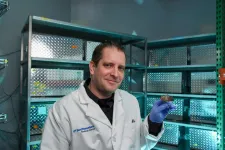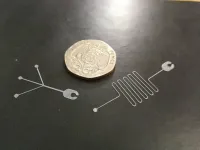(Press-News.org) Like weeds sprouting from cracks in the pavement, cancer often forms in sites of tissue damage. That damage could be an infection, a physical wound, or some type of inflammation. Common examples include stomach cancer caused by H. pylori infection, Barrett's esophagus caused by acid reflux, and even smoking-induced lung cancer.
Exactly how tissue damage colludes with genetic changes to promote cancer isn't fully understood. Most of what scientists know about cancer concerns advanced stages of the disease. That's especially true for cancers such as pancreatic cancer that are usually diagnosed very late.
Researchers in Scott Lowe's lab at the Sloan Kettering Institute are now trying to zero in on the earliest stages of pancreatic cancer development.
"If we understood how these tumors form, maybe we could catch them before the cancer has progressed to an incurable stage," says Direna Alonso Curbelo, a postdoctoral fellow in the Lowe lab who is the first author of a new paper published February 3 in Nature.
Using advanced genomic techniques and innovative mouse models, the researchers were able to discern how tissue damage synergizes with specific genetic changes to promote the earliest stages of pancreatic cancer.
Wound Repair Gone Wrong
It starts with the activation of a normal repair process in response to damage -- damage, it turns out, that can be inflicted by the pancreas's own digestive enzymes.
"The pancreas is like a mini factory of enzymes made to break down food," Dr. Alonso Curbelo says. "If these enzymes are released out of place, they can degrade the tissue and cause pancreatitis [a form of inflammation]."
Fortunately, the pancreas is really good at repairing itself. During the repair response, the cells in the damaged area change their behavior. They temporarily shut down their production of digestive enzymes and take on a different form. They return to their normal functioning once the damage has been resolved. At least, that's what's supposed to happen.
But when these damaged cells also contain a genetic mutation in a gene called KRAS, the wound-healing response goes haywire and the cells never return to normal. Mutant KRAS is known to drive tumor growth in 95 percent of people with pancreatic cancer, but it has so far been unclear how mutant KRAS derails the wound-healing process to initiate the disease.
Dr. Alonso Curbelo and colleagues were able to identify what distinguishes the normal repair process from the cancer-initiating one at the molecular level. They found major changes in how chromatin is organized that were uniquely induced in damaged KRAS-mutant cells. (Chromatin is the combination of DNA and proteins that make up chromosomes.) As a result of these changes, different genes are turned on and off, and the cells take on early cancerous properties.
Opening the Wrong Instructions
Think of the process like opening and closing a zip file. Parts of a chromosome that should be open for normal pancreatic function are inadvertently zipped. Conversely, other parts that are usually zipped are opened. As a result, the wrong set of genetic instructions is available to the damaged cell, which gets confused about its identity.
The whole process happens very quickly. Researchers found that over half of the chromatin changes that typically characterize advanced pancreatic cancer were already present in these cells within 48 hours of tissue damage. Because these cancer-associated changes in gene expression are not caused by changes in DNA sequence, they are called epigenetic (epi meaning beyond, genetic meaning genes).
This discovery is important because it suggests that scientists could potentially block cancer development by interfering with the activation of genes that become inappropriately turned on. And indeed, the team showed that they could do just that: When they prevented their activation in the damaged cells in the mice, the initiation of pancreatic cancer was blunted.
It Takes Two
Interestingly, these early, cancer-associated epigenetic changes did not occur when either mutant KRAS or tissue damage were present separately. Only the combination triggered it.
"Our study provides some understanding of why cancers often arise at sites of tissue damage," Dr. Lowe says. "You need both a mutated gene and tissue damage to activate the epigenetic program that drives cancer initiation. Each alone does not do it."
The discovery of epigenetic changes at the heart of cancer initiation, and their high degree of specificity, opens up the possibility that scientists could try to target these newly turned-on genes as a way to selectively interrupt cancer development.
As well, scientists might one day be able to use these genes as markers to identify early signs of cancer and intervene before it's too late.
INFORMATION:
This research was supported by the NCI Cancer Center Support Grant (P30 CA08748), the National Institutes of Health (NIH; grants F31CA246901, F99CA245797, K99CA237736, 1F32CA177072-01, K99CA23019, P01CA13106, R01CA204228, P30CA023108, and U54CA209975), Cycle for Survival, the Marie-Josée and Henry R. Kravis Center for Molecular Oncology, the Spanish Fundación Ramón Areces, the American Cancer Society, the Pancreatic Cancer Action Network-AACR Pathway to Leadership Award, the Jane Coffin Childs Memorial Fund for Medical Research, the David Rubenstein Center for Pancreatic Research, the Alan and Sandra Gerry Metastasis and Tumor Ecosystems Center, the Lustgarten Foundation, and the Agilent Thought Leader Program. Dr. Lowe is an investigator in the Howard Hughes Medical Institute and the Geoffrey Beene Chair for Cancer Biology. A patent application has been submitted based in part on results described above. Dr. Curbelo and Dr. Lowe are listed as the inventors. Dr. Lowe is a founder and scientific advisory board member of Blueprint Medicines, Mirimus Inc., ORIC pharmaceuticals, and Faeth Therapeutics, and on the scientific advisory board of Constellation Pharmaceuticals and PMV Pharmaceuticals.
Researchers at the Centro Nacional de Investigaciones Cardiovasculares (CNIC) led by Professor Francisco Sánchez-Madrid have found that dendritic cells, which initiate specific immune responses, can reprogram their genes to improve their immune response. The results of the study, funded by Fundación 'la Caixa' and published today in Science Advances, could have important applications in the development of new vaccination and immunotherapy strategies.
Dendritic cells are professional antigen-presenting cells that initiate adaptive or specific immune responses. As described by the research team, "dendritic cells capture possible pathogenic agents in different tissues and entry sites, process their components, and transport them to lymph nodes. Here, they ...
Captive marmosets that listened in on recorded vocal interactions between other monkeys appeared to understand what they overheard - and formed judgements about one of the interlocutors as a result, according to behavioral analyses and thermal measurements that corresponded with the marmosets' emotional states. The findings suggest that the eavesdropping monkeys perceived these vocalizations as "conversations" rather than isolated elements and indicate that, on the whole, they prefer to interact with cooperative rather than noncooperative individuals. However, the researchers observed notable differences in how male or female and breeder or helper animals (those without their own offspring) reacted after eavesdropping. While behavioral ...
Scientists have developed a monitoring system based on commercial smartwatches that can detect movement issues and tremors in patients with Parkinson's disease. The system was tested in a study involving 343 patients - including 225 who the researchers followed for 6 months. The system gave evaluations that matched a clinician's estimates in 94% of the subjects. The findings suggest the platform could allow clinicians to remotely monitor the progression of a patient's condition and adjust medication plans accordingly to improve outcomes. Parkinson's disease is marked by a breakdown in voluntary movement ...
Participants in an international survey study reported greater willingness to reshare a call for social distancing if the message was endorsed by well-known immunology expert Anthony Fauci, rather than a government spokesperson or celebrity. Ahmad Abu-Akel of the University of Lausanne, Switzerland, and colleagues Andreas Spitz and Robert West of the École Polytechnique Fédérale de Lausanne, report these findings in the open-access journal PLOS ONE on February 3.
Previous research has extensively explored how to maximize the effectiveness of public health messages by altering their style and content. However, relatively few studies have examined the impact of spokesperson identity on the effectiveness of health messages, especially during crises like the ongoing COVID-19 ...
DALLAS - Feb. 3, 2021 - Inactivating a gene in young songbirds that's closely linked with autism spectrum disorder (ASD) prevents the birds from forming memories necessary to accurately reproduce their fathers' songs, a new study led by UT Southwestern shows.
The findings, published online today in Science Advances, may help explain the deficits in speech and language that often accompany ASD and could eventually lead to new treatments specifically targeting this aspect of the disorder.
Study leader Todd Roberts, Ph.D., associate professor of neuroscience and a member of the Peter O'Donnell Jr. Brain Institute at UT Southwestern, explains that the vocalizations that comprise a central part of human communication are relatively unique among ...
A novel artificial intelligence (AI) approach based on wireless signals could help to reveal our inner emotions, according to new research from Queen Mary University of London.
The study, published in the journal PLOS ONE, demonstrates the use of radio waves to measure heartrate and breathing signals and predict how someone is feeling even in the absence of any other visual cues, such as facial expressions.
Participants were initially asked to watch a video selected by researchers for its ability to evoke one of four basic emotion types; anger, sadness, joy and pleasure. ...
(Boston)-- While a number of topical products designed to reduce the occurrence of sexually transmitted infections have been tested with largely disappointing results, researchers at Boston University School of Medicine (BUSM), Alpert Medical School of Brown University and Mapp Biopharmaceutical have now found that MB66, a vaginal film product containing monoclonal antibodies against human immunodeficiency virus-type 1 (HIV-1) and herpes simplex viruses types 1 and 2 (HSV-1 and 2), is safe and effective.
HIV-1 and HSV-1 and 2 are relatively common sexually transmitted infections associated with significant illness and sometimes even death. Though antiviral drugs can suppress viral concentrations and dramatically slow ...
Humans continuously observe and evaluate interactions between third parties to decide with whom to interact in the future. But it is difficult to measure what information animals gain when they eavesdrop on vocal interactions between conspecifics: If they do understand such conversations, they do not necessarily exhibit behavioral expressions that can be easily observed. To overcome this hurdle, anthropologists from the University of Zurich created a study combining call simulations, thermography methods and behavioral preference measures.
Using thermal imaging, the researchers were able to non-invasively measure temperature changes in the faces of marmoset monkeys to quantify ...
Narrowing of the trachea or the main bronchi due to injury or illness can end very badly. If patients get too little air,oxygen, they risk suffocating and often need medical help as quickly as possible.
Surgeons insert stents made of medically usable silicone or metal as a way of treating these patients. Although they quickly bring relief, the implants also have disadvantages: Metal stents have to be removed surgically with some effort, which is a burden for the patients, while silicone stents often migrate away from the insertion site. The reason for this is that the implants are not adapted to a patient's anatomy.
An ETH Zurich research team, composed of members of the Complex Materials and Drug Formulation and Delivery groups, has now developed an ...
New technology developed by the University of Bristol has the potential to accelerate uptake and development of on-chip diagnostic techniques in parts of the world where rapid diagnoses are desperately needed to improve public health, mortality and morbidity.
Microfluidic devices underpin lab-on-a-chip (LOC) technologies which are developed to provide the rapid diagnoses at that are needed at point of care (POC) for the swift and effective treatment of many diseases.
Researchers at Bristol have developed a fast, reliable and cost-effective alternative for producing the soft-lithographic moulds used for fabricating microfluidic devices, published in the journal ...




